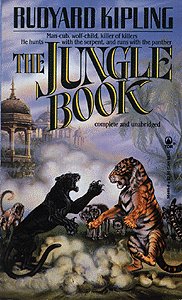
by Eric Schmoyer
The new film from Disney, Rudyard Kipling's The Jungle Book, was getting acceptable reviews, so I went to see it about a week ago. After the movie, I mentioned reading some of The Jungle Book long ago, and was asked, "So how different is the book?" The official question these days, right?
I'm sure that there are quite a number of us out there who read
something long ago and only dimly remember the story. Well, I actually
did read The Jungle Book long, long ago, but all I remembered
was a story about a mongoose and two cobras in a garden, and nothing about
a boy raised by wolves. This just didn't add up. So, what better thing
to do than run right out, grab a copy, and re-read it, right?

I realized that The Jungle Book is a collection of short stories that are mostly about life in the Indian Jungle. There are three stories that involve Mowgli. The original stories are adventurous, but not love stories by a longshot. The characters are quite a bit harsher in the book, as is expected in a hostile jungle environment. Mowgli first meets the bander-log (Monkey people) because he ran off after being hit in the head by Baloo for not remembering some of his lessons. In the end, Shere Kan is killed, but with help from the wolf council leader and one of Mowgli's wolf brothers. Baloo and Bagheera have a very small role in the later part of Mowgli's life. While both of Disney's versions borrow only lightly from Kipling's stories, I found the animated version from 1969 a bit closer to the plot of Kipling's stories than the movie currently playing in the theaters.
The Jungle Book also contains four other stories that are quite unrelated to Mowgli, the most famous of which is "Rikki-Tikki-Tavi", the story I read when I was younger. It is the story of a mongoose who protects a family from a pair of cobras who live in the family's garden. I'm told there is also an animated version of this story as well. Two other stories, "Toomai of the Elephants" and "Servants of the Queen", share the same settings you expect of the Jungle Books. However, "The White Seal" opens on the isle of St. Paul in the Bering Sea. Although the setting is quite a reversal from the steamy and exotic Indian Jungle, the story shares the common thread of expertly developed animal characters and a storytelling style that entrances the reader.
Originally the stories were published separately, but you can now find them compiled within the covers of The Jungle Book. I'd recommend grabbing a copy the next chance you get.

